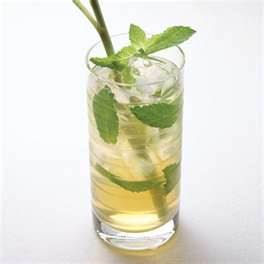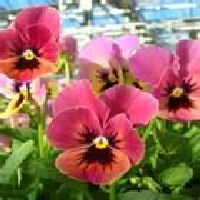Table of Contents
Edible flowers in containers – have you considered that many of the flowers you grow can be eaten? Many flowers are safe to eat and the flowers of most culinary herbs are edible.
Flowers and herbs have been used for culinary purposes for centuries. They add extra flavor to salads, desserts, sauces, soups or an entree. Ancient cultures utilized fennel, violets and roses to add scent, color and flavor in their dishes.
Today there is renewed interest in edible flowers. They are a healthy alternative to salt and sugar and add beauty and color to your dishes.
When growing edible flowers in containers to eat or use as garnish, keep in mind:
- Proper identification is important
- Edible flowers in containers should be grown without pesticides
- For best flavor, use flowers at their peak
- Introduce new flowers into your diet slowly so you can recognize any potential allergy
- Edible flowers in containers can be preserved in oils and vinegars
Generally avoid purchasing flowers from florists, garden centers or nurseries if you plan to use them in recipes or as garnish. They have not been grown for consumption.
At least 3 percent of all poisonings are plant related, according to the National Safety Council. Make sure you know if a plant is edible before adding it to your recipes.

To avoid stomach upset or to determine if there is an allergic reaction, try a small quantity of the new flowers yourself. Edible petals or entire flowers can be eaten. Remove stems, anthers and pistils though, because they may be bitter.
Many edible flowers in containers are high in vitamin C and/or vitamin A, along with other essential nutrients. Use them as garnishes and in salads.
Recipes for flowers may be found in the following areas: baking, sauces, jelly, syrup, vinegars, honey, oil, tea, flower-scented sugars, candied flowers, wine and flavored liquors.
Pick the flowers, rinse with gently running water and place between damp paper towels. Refrigerate until ready to use. Some varieties may last longer if not washed until they are ready to use. Some edible flowers in containers may be dried and used as herbs.
Check out HomeCooking for ideas and recipes. A few of their hints are:
- Violets, roses and lavender lend a sweet flavor to salads or desserts. Bright yellow marigolds are an economic alternative to saffron, which is expensive. Other flowers have spicy or minty flavors.
- Edible flowers as a garnish make any dish look special but be sure the flavor of the flower compliments the dish.
- Place a colorful gladiolus or hibiscus flower (remove the stamen and pistil) in a clear glass bowl and fill with your favorite dip.
- Sprinkle edible flowers in your green salads for a splash of color and taste.
- Freeze whole small flowers into ice rings or cubes for a pretty addition to punch or other beverages
- Use in flavored oils, vinaigrettes and jellies
- One of the most popular uses is candied or crystallized flowers. Use them to decorate cakes or fine candies.
- Asthmatics or others who suffer allergic reactions to composite-type flowers (calendula, chicory, chrysanthemum, daisy, English daisy, and marigold) should be on alert for possible allergic reaction.
- Never use non-edible flowers as a garnish. You must assume that if guests find a flower on a plate of food, they will think it is edible.
Some flowers to try
According to the Colorado State University Extension office, here are some suggestions for edible flowers in containers. You may be planting some of the flowers already. Now you can try them in your recipes and as garnishes for drinks, etc. You can also check their site for flowers that are toxic and a complete list of edible flowers.
Allium schoenoprasum – Chive – Perennial – Lavender, red to purple blooms – onion taste – strong onion scent – separate florets to serve.
Allium tuberosum – Garlic Chive – Perennial – White blooms – onion taste – strong onion scent – separate florets to serve
Anethum graveolens – Dill – Annual – Yellow blooms – taste is stronger than leaves – scent is dill
Anthemis nobilis – English chamomile – Perennial – White petals with yellow center – sweet apple flavor – ragweed allergy sufferers may be allergic to chamomile and should drink no more than one cup of tea per day.
Begonia x tuberhybrida – Tuberous begonia – Tender perennial – These edible flowers for container gardens have white, pink, red, yellow or orange blooms – citrus taste – only hybrids are eligible.
Bellis perennis – English daisy – Perennial – White to purple petals – mild to bitter taste – use as garnish or in salads.
Calendula officinalis – Calendula, pot marigold – Annual – Yellow to orange blooms – tangy and peppery taste – ornamental – dries well
Chrysanthemum coronarium – Garden chrysanthemum – Perennial – These edible flowers for container gardens have yellow to white blooms – its use is ornamental
Citrus limon – Lemon – Perennial – White blooms – Citrus, slightly bitter taste – Sweet floral scent
Citrus sinensis – Orange – Perennial – White blooms – Citrus taste – Sweet, strong perfume
Cucurbita spp – Squash or pumpkin – Annual – Orange, yellow blooms – Raw squash taste – Slightly floral scent
Dendranthema x grandiflorum – Chrysanthemum – Perennial – White, red, yellow, pink, orange, purple – Strong to bitter taste – Pungent scent – ornamental
Dianthus spp – Dianthus or pinks – Perennial – Pink, white or red – Spicy, clove taste and scent. Some varieties are spicier – Ornamental
Foeniculum vulgare – Fennel – Perennial – Pale yellow – Licorice taste is milder than leaves – Sweet scent
Hemerocallis fulva – Daylily – Perennial – These edible flowers for container gardens are a tawny orange in color. Its taste is a combination of cooked asparagus / zucchini. All parts are edible. Eat in moderation as daylilies may act as a diuretic or laxative.
Hibiscus rosa-sinensis – Hibiscus, China rose – Perennial – Orange, red, purplish – Citrus cranberry flavor – used in many tea flavorings
Hibiscus syriacus – Rose of Sharon – Perennial – White, purple, violet – Nutty taste
Hyssopus officinalis – Hyssop – Perennial – Blue, pink, white – Bitter taste, similar to tonic – Used to flabor chartreuse, a liqueur, strong flavor
Lavandula angustifolia – Lavender – Perennial – Lavender, purple, pink, white – Highly perfumed – floral taste may be strong depending on plant
Malus spp – Apple or crabapple – Perennial – White to pink – Slightly floral to sour-sweet floral – petals may be candied – Seeds are poisonous
Melissa officinalis – Lemon balm – Perennial – Creamy white – Lemony taste – Sweet lemon herb
Mentha spp – Mint – Perennial – Pink to white – Minty taste is milder than leaves – Fresh, minty herb
Monarda didyma – Bee balm – Perennial – Red, pink, white, lavender – Tea like, more aromatic than leaves – Sweet, perfumed scent – Attracts butterflies and hummingbirds
Ocimum basilicum – Basil – Annual – White to pale pink – Taste is milder than leaves – Spicy scent
Origanum majorana – Marjoram – Tender perennial – Pale Pink – Spicy, sweet taste and scent – herb
Origanum spp – Oregano – perennial – White – Spicy, pungent like leaves – Herb
Pelargonium spp – Scented geranium – Tender perennial – These edible flowers for container gardens are white, red, pink, or purple – Its scent varies from rose to lemon – Ornamental
Pisum sativum – Garden pea – Annual – White, tinged pink – Taste is raw peas – Vegetable
Raphanus sativus – Radish – Annual – White, pink, yellow – Spicy taste
Rosa spp – Rose – Perennial – White, pink, yellow, orange, red – Highly perfumed – Sweet to bitter taste – Ornamentao – remove sour petal base
Rosmarinus officinalis – Rosemary – Tender perennial – Pale blue, dark blue, pink, white – Taste depends on cultivar – Mild rosemary scent – Delicate herb – do not cook flower
Thymus spp – Thyme – Perennial – Purple, white – Taste is milder than leaves – herb
Tropaeolum majus – Nasturtium – Annual – Taste is watercress or peppery – use in salads.
Viola odorata – Violet – Perennial – Violet, pink, white – Sweet taste, Sweet ornamental scent – Candies well
Viola x wittrockiana – Pansy or Johnny Jump-up – Annual – These edible flowers for containers come in lots of colors including violet, white, pink, yellow, and multi-colored. It has a stonger taste than violets – Ornamental
Yucca filamentosa – yucca – Perennial – Creamy white with purple – Taste has hint of artichoke, slightly bitter – Ornamental
Return from Edible Flowers in Containers to Edible Gardening
Return Home enjoycontainergardening.com















New! Comments
Please leave me a comment and let me know if you like what you see here and if the information is helpful. Thanks.